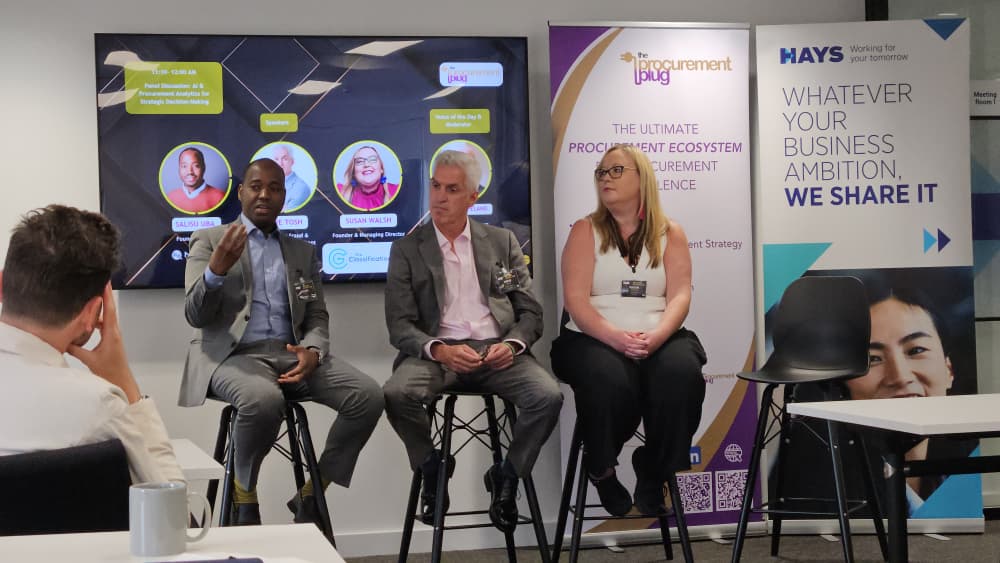S Uba, FCIPS – NatQuest CEO 31 March 2025
Artificial intelligence (AI) possesses the capability to significantly transform procurement processes through the introduction of data-driven decision-making, process automation, and predictive analytics, among other advancements. However, the successful integration of AI necessitates more than mere technological adoption; it requires a well-defined implementation strategy that is aligned with organisational objectives and capabilities.
At NatQuest, we are dedicated to leveraging our expertise, practical experience, and knowledge-based approach to facilitate your success in the AI landscape. To this end, we have developed the AI FOCUS framework—comprising Find Opportunities, Organise Resources, Create Roadmap, Unleash Implementation, and Sustain and Improve.
– S Uba
This framework serves as a comprehensive guide for procurement leaders aiming to effectively develop and operationalise AI within their functions.

Find Opportunities
The foundation of any artificial intelligence strategy should be a pragmatic evaluation of the potential value that AI can bring to procurement operations. Instead of prioritising technological advancements, organisations must first identify their existing challenges and operational inefficiencies.
Key areas typically ripe for AI application include:

Organisations should undertake a comprehensive data audit to evaluate the availability, quality, and accessibility of both structured and unstructured procurement data. Engaging stakeholders—particularly procurement category managers, information technology teams, finance departments, and legal representatives—is essential to identify practical use cases and to secure organisational buy-in. A study conducted in 2023 by the MIT Center for Digital Business indicates that organisations that initiate their artificial intelligence journey by aligning use cases with operational challenges experience a 25% reduction in implementation time and achieve a higher return on investment.
Organise Resources
Effective implementation depends on organising the necessary human, technological, and financial resources.
This includes:
- Capability building: Recruit or upskill personnel in data science, procurement analytics, and AI operations. Hybrid roles that combine procurement expertise with technical acumen are increasingly in demand.
- Budgeting and vendor selection: Allocate resources for technology licensing, integration, training, and support. Due diligence on AI solution providers should include scrutiny of their data governance practices and track record in procurement.
- Data governance: Establish robust policies for data ownership, privacy, security, and quality assurance. Procurement leaders must work closely with data stewards and compliance officers to address regulatory and ethical obligations, particularly under GDPR.
According to Gartner’s 2024 Procurement Technology Report, over 60% of failed AI projects in procurement cite weak data infrastructure or governance as the root cause.
Create Roadmap
Once foundational requirements are in place, organisations must articulate a coherent implementation roadmap. This should translate strategic intent into an operational plan, including clear metrics of success.
Key components of the roadmap should include:
- Use case prioritisation: Focus initially on quick-win projects that are low risk but high impact, such as invoice automation or contract data extraction.
- Timeline and phasing: Develop a phased rollout plan that allows time for iteration, feedback, and system training.
- KPIs and governance structure: Define metrics to monitor performance, adoption, and ROI. Establish a cross-functional steering committee to oversee implementation and manage risks.
Leading firms adopt an agile methodology, allowing for continuous refinement of their roadmap based on pilot results and organisational feedback loops.
Unleash Implementation
Operationalising AI involves piloting, testing, and scaling solutions within real procurement environments.
Best practices include:
- Pilot testing: Conduct controlled trials with select categories or processes to validate hypotheses, measure impact, and address operational issues.
- Change management: Engage users early, communicate clearly, and provide training to build confidence and adoption. Resistance is often rooted in uncertainty and a perceived threat to jobs; communication must address these concerns directly.
- Technology integration: Ensure AI systems integrate with existing ERP, contract lifecycle management, and supplier relationship systems to avoid silos.
Sustain and Improve
AI implementation is not a one-off initiative but an ongoing programme requiring continuous refinement.
To sustain value, organisations must:
- Monitor and adapt: Use dashboards to track KPIs in real time and flag underperformance. Periodic model retraining is essential to maintain predictive accuracy.
- Institutionalise learning: Conduct post-implementation reviews to extract lessons and feed them into future deployments.
- Scale intelligently: Extend successful use cases across categories or geographies, but only where data maturity and operational readiness exist.
Sustaining AI also requires vigilance around bias, drift, and unintended consequences. Ethical considerations, particularly transparency in algorithmic decision-making, should be embedded in AI governance.
What Procurement Professionals Must Focus On
AI implementation reshapes procurement roles. Professionals must shift from transactional tasks towards strategic, analytical, and technology-enabled responsibilities. The following focus areas are critical:
- Analytical literacy: Understanding how AI models work and what their outputs mean is essential for interpreting insights and making defensible decisions.
- Data stewardship: Procurement professionals will increasingly serve as custodians of data quality, accuracy, and relevance.
- Ethics and accountability: Decisions influenced by AI—such as supplier selection or risk scoring—must meet ethical and legal standards. Procurement professionals must understand the implications and build in appropriate checks.
- Supplier engagement: AI should not be imposed unilaterally. Suppliers must be brought into the process, particularly when systems require their data inputs or involve collaborative platforms.
A recent Harvard Kennedy School paper on public sector AI adoption underscores the importance of procurement practitioners acting as “ethical gatekeepers,” not merely process executors.
Case Study: Implementing an AI-Driven Tender Development Tool Using the FOCUS Framework
The Procurement Director of a large government infrastructure agency identified significant delays and inconsistencies in their tender development processes. Manual drafting, fragmented templates, and compliance issues were affecting timelines and supplier engagement. The goal was to introduce an AI-driven tool to streamline tender creation, reduce errors, and improve transparency.
The Director adopted the FOCUS framework and partnered with NatQuest SCM Genius, leveraging their domain expertise and AI capabilities tailored for procurement functions.
Step 1: Find Opportunities
The Director commissioned a diagnostic review of the current tendering process. Key findings included:
- Average tender development cycle: 18–22 working days
- Repetition of standard clauses across multiple tenders
- High dependency on a few experienced procurement staff
- Inconsistent language and compliance gaps
Using internal data and interviews, the team identified tender drafting as a high-impact use case for AI intervention. The business case was clear: reduce cycle times by 30%, improve legal compliance, and enable junior staff to take on drafting tasks confidently.
Step 2: Organise Resources
The Director formed a dedicated project group with representatives from:
- Procurement and legal teams
- ICT and digital transformation office
- Internal audit and compliance
- External support from NatQuest SCM Genius
A modest budget was approved for licensing, training, and integration work. Data samples from previous tenders were collected, cleaned, and tagged for training the AI model. Templates, clauses, risk matrices, and contract standards were digitised to create a central knowledge base.
NatQuest provided a pretrained AI engine fine-tuned for public sector procurement, enabling fast onboarding.
Step 3: Create Roadmap
A three-month implementation roadmap was created:
- Month 1: Configure tool, train the AI model on past tender documents, run user workshops
- Month 2: Pilot in three departments (Transport, Professional Services and ICT)
- Month 3: Evaluate pilot, capture feedback, adjust model and interface, prepare for enterprise rollout
Key KPIs included:
- Time taken to draft standard and complex tenders
- Error rates in draft tenders
- User satisfaction and adoption rates
- Legal compliance scores
Weekly stand-ups and a governance board were established for accountability.
Step 4: Unleash Implementation
The AI Tender Assistant, powered by SCM Genius, was rolled out in pilot units. Core features included:
- Automated clause suggestion based on category, value, and risk profile
- Compliance checks aligned with procurement law and internal policy
- Collaboration interface for legal and procurement input
- Version control and audit trail
Procurement officers could enter a basic brief and receive a full draft tender in under 20 minutes. Legal teams appreciated the structured clause logic and clear flags for customisation.
SCM Genius’s implementation consultants provided real-time support, onboarding sessions, and weekly refinement updates.
Step 5: Sustain and Improve
Following the successful pilot, the tool was scaled across all departments. The outcomes after six months:
- Tender drafting cycle time was reduced by 43%
- 92% reduction in legal rework requests
- User satisfaction at 4.6 out of 5
- Increased compliance with internal procurement policy
A Centre of Excellence was established to capture lessons, support future AI use cases, and manage model drift. The procurement team now contributes to model updates and clause library improvements.
The Procurement Director stated:
“Partnering with NatQuest SCM Genius was pivotal. Their deep understanding of procurement realities—not just tech—helped us avoid common pitfalls and design a solution that fits how we actually work.”
Conclusion
Building an AI strategy in a procurement organisation is less about technology and more about alignment—between organisational goals, data readiness, people capability, and risk appetite. The FOCUS framework offers a pragmatic route through what can otherwise be an opaque or fragmented process. Procurement leaders who take a disciplined, stakeholder-centric, and ethically grounded approach will be better positioned to unlock long-term strategic value from AI.
What help with your AI Procurement Strategy
Engage with some of the top expert on SCM Genius Network

Dr. Salisu Uba, FCIPS, is a procurement technology expert interested in AI implementation in the supply chain. If you want to engage, Salisu, check the SCM Genius Network.




